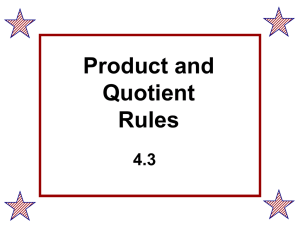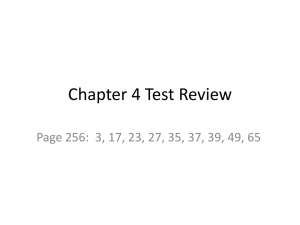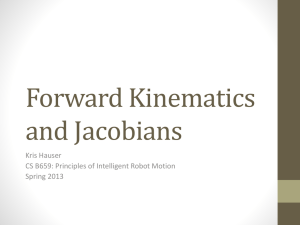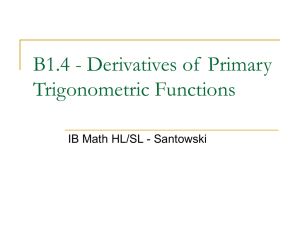HELM Workbook 11 (Differentiation) EVS Questions
advertisement
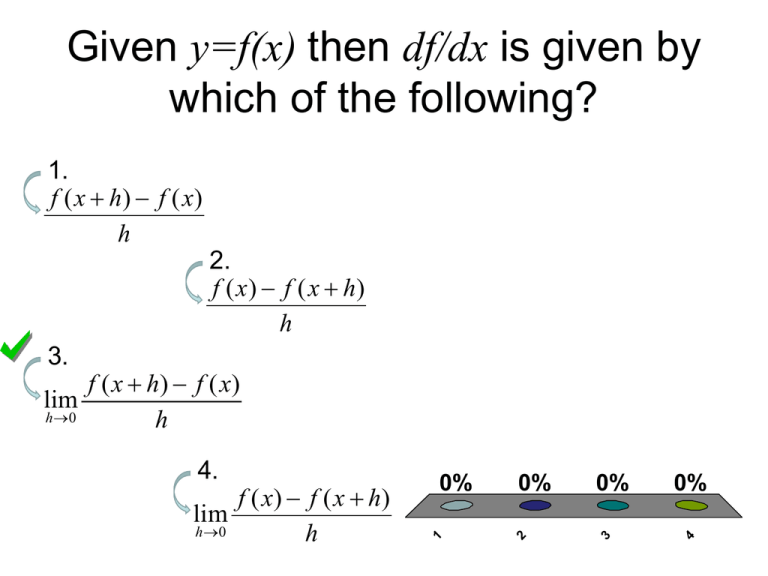
Given y=f(x) then df/dx is given by which of the following? 1. f ( x h) f ( x ) h 2. f ( x ) f ( x h) h 3. f ( x h) f ( x ) lim h 0 h 0% 4 0% 3 0% 2 f ( x ) f ( x h) lim h 0 h 0% 1 4. cos( 2 x h) cos( 2 x) lim h 0 h 1. 2. 3. 4. equals -2sin2x -sin(2x) 0 -2xsin2x 0% 1 0% 0% 2 3 0% 4 If y=xn then find dy/dx nxn nxn-1 xn-1 (n-1)xn -1 )x n 0% (n -1 0% xn n1 0% nx n 0% nx 1. 2. 3. 4. Find the derivative of f(x)=3x³-½x²+5x+1 with respect to x 9x² - 2x + 5 9x³ - x² + 5x + 1 9x² - x + 5 9x³ - x² + 6 0% 4 0% 3 0% 2 0% 1 1. 2. 3. 4. If -3e3x 3e3x -3e2x -3xe2x xe 2x 0% -3 e2 x 0% -3 3x 0% 3e e3 x 0% -3 1. 2. 3. 4. dy y e then find dx 3x df f(k)=tan3k, find dk 3sec3k sec3k 3sec²3k sec²3k c² 3k ²3 k ec 3s c3 0% se 0% k 0% se ec 3k 0% 3s 1. 2. 3. 4. d cos( x) = dx 1. 2. 3. 4. 5. sin(x) -sin(x) cos(x) -cos(x) cosec(x) 0% 1 John Goodband, Coventry University 0% 2 0% 0% 3 4 0% 5 d dx x = 1. 2 x 4. 2 x 2. 1 x 2 3. 1 5. 1 1 .5 2( x ) 2 x 0% 1 John Goodband, Coventry University 0% 2 0% 0% 3 4 0% 5 d ln x = dx 1. 0% 1 1 x ln x ln x John Goodband, Coventry University 0% 0% 0% 0% 5 3. 5. 4 1 x xln x 3 2. 4. 2 e x 3 Find the derivative of y 2 x with respect to x 1. 3 2x 3 4. 0% 0% 0% 4 0% 3 6x 3 2 6x 6 x 1 3. 2. Find the derivative of z = 2sint – cos2t with respect to t 2cost + sin2t 2cost – sin 2t 2cost + 2sin2t 2cost – 2sin2t 0% 4 0% 3 0% 2 0% 1 1. 2. 3. 4. If f ( x) cos x then 1. f ( x) f ( x) 2. f ( x) f ( x) 3. f ( x) sin(x) 4. 0% 4 0% 3 0% 2 0% 1 All of the above Which of the following statements are true? 1. The derivatie of f(x)+g(x) is df dg dx dx 2. The derivative of f(x)-g(x) is df dg dx dx 3. If k is constant, the dk derivative of kf(x) is dx 4. If y=f(x)g(x) then dy df dg g(x) f(x) dx dx dx 0% 1 0% 0% 2 3 0% 4 d cos x 2 x e sin 2 x dr 1. 2. 3. 4. equals 2-ecosxsinx +2xcos2x x+ ecosx +2cos2x 2-ecosxsinx +2cos2x Not enough information 0% 1 0% 0% 2 3 0% 4 Find the derivative of y=2xe-x with respect to x 1. 2. 3. 4. -2xe-x + 2e-x -2xe-x + 2e-x 2xe-x – 2e-x 2xe-x + 2e-x 0% 1 0% 0% 2 3 0% 4 Find the derivative of y=(e2x)6 with respect to x 6e2x 12e12x 12xex 12ex ex 0% 12 xe 12 2x e1 12 0% x 0% 2x 0% 6e 1. 2. 3. 4. d 2 sin( x )= dx 2xcos(x²) cos(x²) 2xcos(x) x²cos(x²) + 2xsin(x²) John Goodband, Coventry University 0% 0% 4 0% 3 1 0% 2 1. 2. 3. 4. Which of the following is the quotient rule if y f ( x) ? g ( x) 1. dy df dg g ( x) f ( x) dx dx dx 2. dy df dg g ( x) f ( x) dx dx dx df dg f ( x) dx dx g ( x)2 0% 0% 0% 0% 4 dg df f ( x) g ( x) dy dx dx dx g ( x)2 3 4. 2 dy dx g ( x) 1 3. Use the quotient rule to find the derivative of f(x)=x-3cosx with respect to x 1. x sin x 3 cos x x4 2. 3 cos x x sin x x4 3. 3x 2 cos x x 3 sin x x6 4. 0% 4 0% 3 0% 2 0% 1 3x 2 cos x x 3 sin x x6 We know f (2) 2 and f (2) 6 . d f ( x) Then dx x equals: x 2 1. 5/2 2. 7/2 3. 3 0% 0% 0% Using the chain rule, find the derivative f(x)=(3x²+2)² with respect to x 2(3x² + 2) 12(3x + 2) 12x(3x² + 2) 12x + 4 0% x( 3x 12 4 + x 12 ²+ 2) + (3 x 12 3x ²+ 0% 2) 0% 2) 0% 2( 1. 2. 3. 4. Suppose a runner has a speed of 8 miles per hour, while a cyclist has a speed of 16 miles per hour. Then dV/dt for the cyclist is 2 times greater than dV/dt for the runner. This is explained by: The chain rule The product rule The quotient rule The addition rule 0% 4 0% 3 0% 2 0% 1 1. 2. 3. 4. The radius of a balloon changes as it deflates. This change in radius with respect to volume is: 1. dV dr 3. 2. dr dV dV dr dr dV 0% 4 0% 3 0% 2 0% 1 4. None of these Calculate the second derivative of y = 4x³ - 2x + x² - 3 with respect to x 24x + 2 24x - 2x 12x - 2 12x² - 2 +2x +2 x 0% 12 x² 12 -2 x x -2 24 x + x 0% -2 0% 2 0% 24 1. 2. 3. 4. 2 d y then find 2 dx 1. 2 6 1 5 5 4 x x x 13 x 2 30 35 12 2. 8 x x 10x 3 2 3. 24x 2 x 10x 26 2 0% 4. 24x 2 x 10 0% 0% 0% 4 3 2 2 3 1 If 1 3 4 2 y 2 x x 5 x 26 3 If x=h(t) and y=g(t) then 1. dy dy dx dx dt dt 2. 3. dy dy dx dx dt dt dy dy dx dx dt dt 4. dy dy dx dx dt dt 0% 1 0% 2 0% 3 0% 4 Find the valuedyof if x=3t2 and dx y=2t-1. 1. 1 3t 3. 12 t 2. 3t 4. 2 6t 0% 1 0% 2 0% 3 0% 4 If x=h(t) and y=g(t) then 1. d y x y y x 2 dx x3 2 2. 3. d2y 2 dx d y y x x y 2 dx 3 x x y y x 2 2 x 4. d y y x x y 2 dx x 2 0% 1 0% 2 0% 3 0% 4 Find the equation of the tangent line to the curve x=1-3sint, y=2+cost at t . 3 1. y 1 1 x4 3 3 2. 1 y 3x 3 3 3. 3 3 y x4 3 3 4. 0% None of the above 1 0% 2 0% 3 0% 4 Which differentiation rule is needed to differentiate implicit functions? 1. 2. 3. 4. Product rule Chain rule Quotient rule Inverse function rule 0% 1 0% 2 0% 3 0% 4 Find dy dx if 3y=xy+siny. 1. y cos y x 3 2. 3. y 3 x cos y x y cos y 3 4. xy 3 y sin y 0% 1 0% 2 0% 3 0% 4 Find d2y at the point 2 dx 2 x +2xy+y2=x. 1. 2. 1 64 289 256 3. 4. 1 256 289 64 0% 1 (3,1) on 0% 2 0% 3 0% 4


